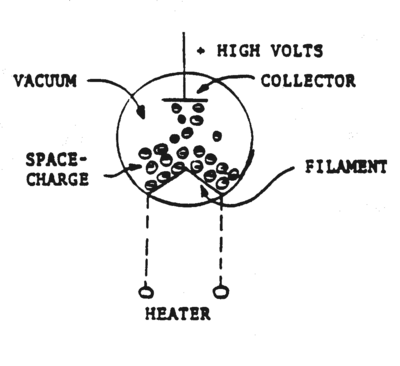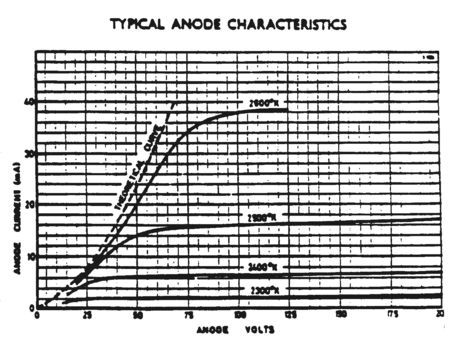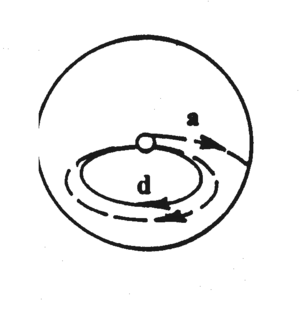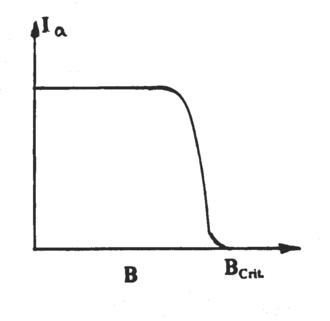Main Page/PHYS 3220/Thermionic
Thermionic Emission
It is well known that when a metal is heated to high temperatures it emits electrons, as in the case of the filament in an electron tube. This phenomenon of thermionic emission is called the Richardson Effect, and was discovered by Thomas Edison in 1883. It is explained by the electron theory of metals and is comparable to the evaporation of liquids. To obtain a thermionic current, both the emitter and the collector are placed in an evacuated vessel and an electric field is applied.
Theory
Part A
Consider a vacuum diode as shown in Fig. 1. The filament (usually a tungsten wire) is heated to a temperature in the vicinity of 2500o K. The electrons emitted by the filament (cathode) are drawn to the collector (anode) when the anode is raised to a high potential (0 to 400 Volts).
Typical current voltage characteristics Ia vs. Va for various values of filament temperature are shown in Fig. 2.
|
Figure 1 |
Figure 2
|
From Fig. 2, note two distinct regimes of operation: a region (known as the space-charge limited region) where Ia increases rapidly with Va; and the saturation region (known as the temperature limited region). At low anode voltages the cathode is surrounded by a dense space-charge of electrons, which are being continually emitted and reabsorbed. Only those electrons which are well away from the cathode are drawn towards the anode, since the electrostatic potential of the electron cloud counteracts the accelerating potential. A separate discussion of the current-voltage characteristic for this region follows below (eq. 2). As the anode voltage is increased, more electrons are drawn out of the space charge region toward the anode. For sufficiently high voltages the space-charge disappears and the beam current is limited by the rate of emission from the cathode, which leads to a saturation of the current. This saturation current depends on the temperature of the emitter and its work function, and is given by the Richardson-Dushman equation (cf.. ref. 1),
| (1) |
where :
- Jo = saturation current density
- A = a proportionality constant given below
- T = temperature of the emitter in K
- W = work function of the metal of the emitter
- k = Boltzmann constant
where m and e are the electron mass and charge, and h is Planck's constant. This theoretical value of A should hold for a pure surface of a single crystal face. The Richardson-Dushman model as stated above oversimplifies the physical situation: e.g., one can introduce a quantum mechanical effect, i.e., the fact that electrons behave as waves and have a transmission and a reflection probability for leaving the surface (refs. 1-3). It is possible to use eq. (1) while treating A not as an absolute constant, but as a parameter that depends on the material and its crystal structure.
Within the space-charge-limited region one uses Poisson’s equation for the potential created by the electron cloud. The I-V characteristic is now given by the Child-Langmuir law. For a diode of cylindrical geometry this is, in MKSA units,
| (2) |
where ra is the radius of the anode, ε0 is the permittivity constant, β is a correction factor to account for the non-zero radius of the cathode. The GRD7 tube in use has a value β2 = 1.1.
Part B
If a magnetic field of strength B is applied parallel to the axis of the diode, i.e. parallel to the filament, the electrons do not move in straight line paths directly to the anode. Their motion becomes complicated as they are accelerated by both the electric and magnetic fields, but from the motion of a charged particle in a magnetic field alone it is clear that the electron trajectories become more curved when B increases. Fig. 3 shows schematically some trajectories of electrons in the tube. Fig. 4 displays the anode current as a function of B; the current goes to zero when B reaches Bcrit , corresponding to trajectory (d) in Fig. 3. To obtain a relation between the parameters and Bcrit, we note that when an electron is at the anode (or just inside it), the electron must have kinetic energy equal to eV, where V is the anode voltage.
This simplified analysis assumes that the electrons acquire a velocity towards the anode due to the electric field. Subsequently the effect of the magnetic field is estimated to compare the gyration radius for a given B with the size of the anode in our configuration.
|
Figure 3 |
Figure 4- Bcrit corresponds to trajectory ‘d’
|
If the electron follows a path that has a magnetic field controlled trajectory parallel to the anode, such as trajectory (d), it cannot be collected by the anode and no current can flow. Thus, we can relate the parameters as follows: when the electron's trajectories have a radius of curvature equal to the anode radius, the current stops, and the smallest B value at which this occurs is Bcrit. We can obtain the particle velocity v from its kinetic energy:
The magnetic field provides the centripetal force to keep it in orbit such that
| (3) |








